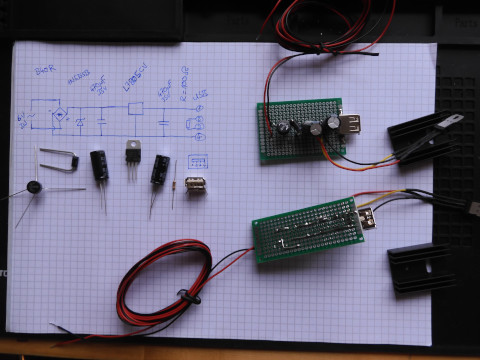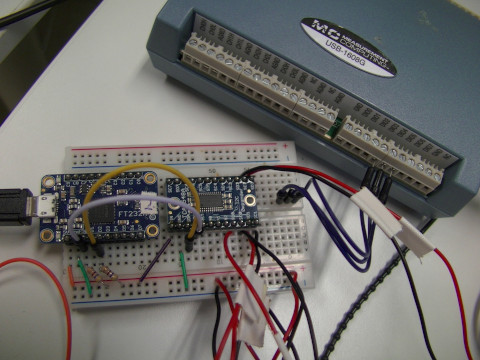What do force plate cables, race track optocoupler components, USB extensions, I2C sensors, and bike lights have in common? I’ve had soldering work with all of them during my PhD project (and hopelessly failed only on the USB cables).
A Home-Made Voltage Rectifier
As a placeholder for all these projects, here comes just a quick fun weekend project that is almost fully covered in a single image:

A home-made voltage rectifier.
My mother in law is planning a long bike tour, and wants to load her smartphone on-the-“fly” (e.g. for navigation). So I built one. As usual, I started from a youtube tutorial and added what people suggested in the comments. I cross-checked with other DIY’s, blogs and info pages, of which there are hundreds.
The components to which it boiled down:
- a voltage rectifier (B40C)
- a Voltage converter (7805; requires cooling)
- a Z-Diode (1N5355; 18V, 5W) to reduce the load on the VCon (probably too big, but I thought I should go over the 3W of a dynamo)
- capacitors (470μF, 35V) to lowpass-filter the voltage peaks
- I even added a 100 Ω resistor to connect the USB data lines, which reportedly is THE trick to fool IPhones into thinking they are on a professional charger.
It still has to pass the practical test. However, even if it fails, there’s little risk involved: electronic parts costed less than 5 EUR, whereas a professional solution can easily go beyond the hundred (which tells you something about the “professionals”).

The adafruit FT232H breakout with an I2C multiplexer to connect 9dof IMU sensord.
Top: MCC USB-1608G DAQ.
Quo vadis, ministry of education?
Why was soldering not taught at my school? By the way, the same question goes for knitting and tailoring, which I would like to have learned, and for which the following is completely analogous.
- It is immensely useful (because it’s all around us).
- It is not too dangerous (under guidance).
- Anyone can learn it, and there is a ton of video material online.
- Basic skills (or at least basic understanding) can prevent capitalistic exploitation and the waste of environmental resources.
- It is cheap, but has a measurable (and even useful) outcome.
- It is amazing how rewarding the simple results (such as a flashing LED) can be, time and time again.
And the funniest thing is: theoretical knowledge does not help too much. I knew Maxwell’s Equations (also from an online lecture) before I soldered. Several serious attempts to teach me soldering have kind of failed in the past [Trotzdem Danke, Papa, für die Versuche und den immer guten Rat!]. It only really sunk in when I was sitting on my own problem, ruining self-paid equipment, and then finding the right youtube videos. By “doing”, not by studying, I learned how to use a multimeter, how long and where to apply heat, and how flux works. I understood the parts listed above, sometimes by braking them. I just lack an oscilloscope for testing, but could usually help myself with batteries, LEDs, and an odroid computer.
Don’t take this as bragging; I’m just advertising the (learning) procedure. I’m definitely far from professional. But with a couple of those lovely through-hole plates, I can bake little circuits and bring them to field work. It’s good for bikes, electric guitars, smartphones. I can solve little problems and make my life easier. And that feels good.

Optocoupler circuit to connect (i) a 12V circuit involving a photoelectric barrier with (ii) 3V digital readout on a tinkering computer.
So grab your soldering iron and get to work if you also want to see your mother-in-law light the christmas tree with bike power!
And enjoy the LED-decorated time of the year, everyone!